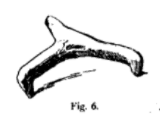


Stilts are small supports used when firing glazed ceramics to stop the melting glaze from fusing them to each other or the kiln. Stilts are a form of kiln furniture. Their presence in archaeological sites, where they may be known as pernette, along with other kiln furniture such as saggars and kiln bars can be used to support a case for local production. Some potters avoid the need for stilts by not glazing the bottom of their products. This is known as dry footing.
History
Various types of stilts have been developed over the centuries:
Tripod stilt
The tripod stilt, which has three legs with a raised point on each end, appears to have been developed in China at least as far back as the third century AD. Tripod stilts have been found during excavations in Ur.
It was adopted by the Islamic world in the 9th century AD and was later adopted by the Byzantines around the start of the 13th century. The use of this stilt can be deduced from damage to the glaze where the three raised points were in direct contact with it. A similar type of stilt appears to have been used in the Staffordshire area and perhaps Scotland between the 1760s and 1850s.
Ring stilt

Ring stilts, which consist of a ring with three raised points of clay placed at equal distances around the rim, were in use in the second half of the 18th century.
Crown stilt
Crown stilts were in use during much the same time period as ring stilts.
Other types

A stilt has been found at a Roman kiln site near Holt, Wrexham County Borough dating to around the first or second century AD. It was designed to be used within a saggar and has clay pads supporting it within the saggar.
Archaeology
In archaeology, they may be upside-down baked clay tripods, leaving characteristic marks at the bottoms of the pottery/porcelain. They expose the bottom of the fired piece to the full heat and prevent the pieces from sticking to each other.
Manufacture
In the 19th century centralised industrial production of molded three-arm stilts began common in the UK with Staffordshire exporting them to other parts of the country. Some of the manufactures appear to have used distinctive mold designs.
Stilts are still used and produced today and are marketed by pottery suppliers.
Non-pottery uses
Some researchers have used kiln stilts as a settlement substrate for coral larva including those of the species Dendrogyra cylindrus.
References
- Elliott, Gordon (2006). Aspects of Ceramic History: A Series of Papers Focusing on the Ceramic Artifact As Evidence of Cultural and Technical Developments. Gordon Elliott. p. 73. ISBN 0955769019.
- ^ Papanicola-Bakirtzē, Dēmētra; Maguire, Eunice Dauterman; Maguire, Henry (1992). Ceramic Art from Byzantine Serres. University of Illinois Press. pp. 25–27. ISBN 0252063031.
- Journal of the American Research Center in Egypt. American Research Center in Egypt. 1965.
- ^ Hunt, Alice M W (2017). The Oxford Handbook of Archaeological Ceramic Analysis. Oxford University Press. p. 151. ISBN 978-0199681532.
- ^ Pat, Spark; Coreson, Linda; Houglum, Lyla (2006). 4-H cast ceramics. Oregon State University. Extension Service. p. 8.
- Stern, Edna J (1998). "Evidence of Early Islamic Pottery Production in Acre". 'Atiqot / עתיקות. 36: 23–25.
- ^ de Alarcon, Tessa (3 July 2014). "Standing on Stilts the Glazed Ceramics from Ur". Penn Museum Blog. University of Pennsylvania Museum of Archaeology and Anthropology. Retrieved 12 April 2018.
- ^ Haggarty, George Raymond. "Newbigging Pottery, Musselburgh:Ceramic Resource Disk" (PDF). National Museums Scotland Research Repository. National Museums Scotland. Retrieved 7 April 2018.
- ^ Peel, R.A (April 1965). "Ceramics: Pottery" (PDF). The crafts of Roman Britain (MA). Durham University. pp. 42–44. Retrieved 8 April 2018.
- Archæological Researches in Palestine During the Years 1873-1874. Committee of the Palestine exploration fund. 1899.
- Marks and Monograms on Pottery and Porcelain: With Historical Notices of Each Manufactory Preceded by an Introductory Essay on the Vasa Fictilia of England, and Followed by a Copious Index. J. Davy. 1866.
- "PERNETTE English Definition and Meaning | Lexico.com". Lexico Dictionaries | English. Archived from the original on February 21, 2022.
- ^ Haggarty, George Raymond. "The Verreville Pottery Glasgow "CD Rom"" (PDF). National Museums Scotland Research Repository. National Museums Scotland. Retrieved 8 April 2018.
- Marhaver, Kristen L; Vermeij, Mark JA; Medina, Mónica M (16 March 2015). "Reproductive natural history and successful juvenile propagation of the threatened Caribbean Pillar Coral Dendrogyra cylindrus". BMC Ecology. 15 (9): 9. doi:10.1186/s12898-015-0039-7. PMC 4361213. PMID 25887933.

| Pottery and claywork | |
|---|---|
| Glossary of pottery terms | |
| Base minerals, and glazes | |
| Main types, by body | |
| Forming techniques | |
| Processes and decoration | |
| Conservation | |
| History of pottery | |